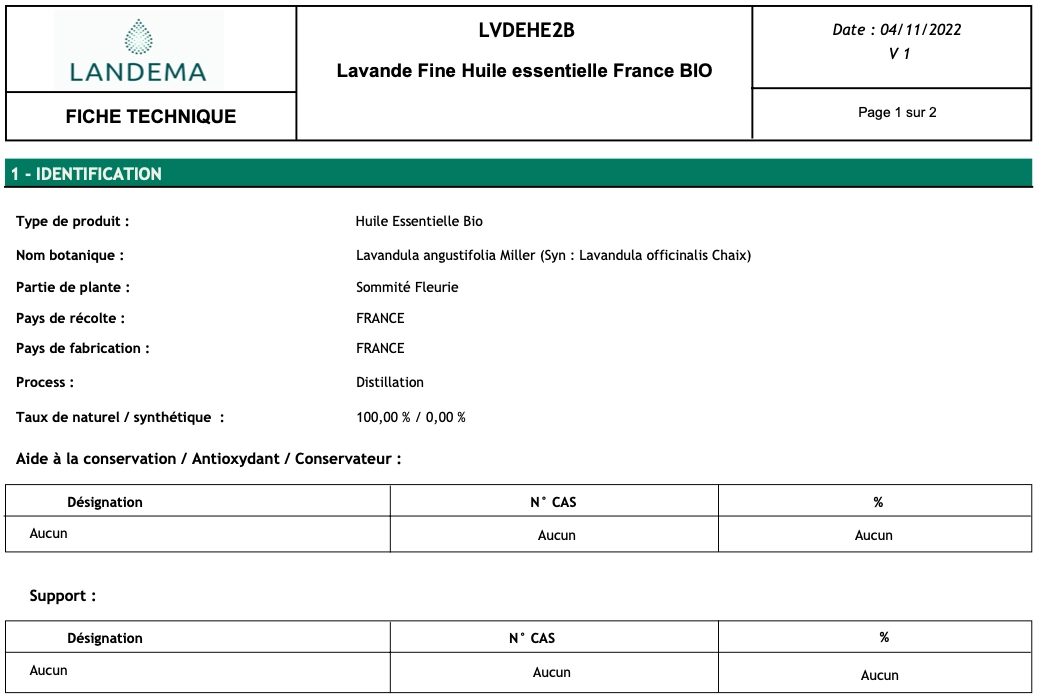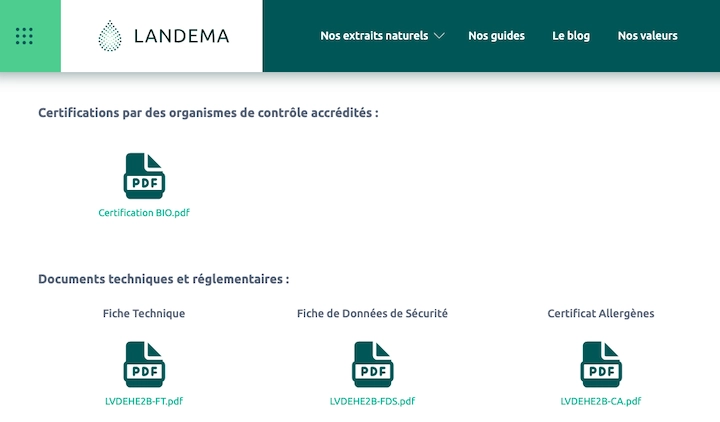
02 avril 2024
Essential oils are increasingly popular and used by professionals in many fields such as cosmetics, aromatherapy, perfumery or household cleaning. Behind these bottles, however, lie powerful and concentrated substances, which are important to use with caution and knowledge.
This is where technical data sheets (TDS) and safety data sheets (SDS) come in, two essential documents that accompany each essential oil. Understanding them well is the key to enjoying all their benefits safely. So, ready to decipher these sheets like a true expert? Landema.com, a specialist in the online sale of essential oils directly from the producer, is here to guide you: let's go!
The 3 key points to remember
The 3 main points to remember from the article you are about to read:
1. The technical data sheet (TDS) is essential for properly choosing and using an essential oil. It details its properties, recommended uses, composition and precautions for use. It is the ideal tool for selecting the oil suited to your needs.
2. The safety data sheet (SDS) warns against potential hazards related to the essential oil: flammability, toxicity, risks of irritation or allergy. It indicates the prevention and first aid measures to know for risk-free use.
3. Properly deciphering these two types of sheets is essential for any professional working with essential oils. This allows for safe use, successful marketing and optimal risk management.

What is a Technical Data Sheet for an essential oil?
The technical data sheet is a document that presents in detail a specific essential oil. It contains all the information needed to know it well and use it appropriately.
It generally includes the following elements:
Product identification
First, the technical data sheet clearly identifies the essential oil, giving:
- Its botanical name and common name
- The part of the plant used (flowers, leaves, bark, etc.)
- The extraction process (distillation, cold expression, etc.)
It also specifies its appearance (colour, consistency, characteristic odour).
Certifications and technical data
Next, the sheet indicates if the essential oil has specific certifications such as organic farming. It also provides precise technical data such as:
- Density
- Refractive index
- Rotatory power
- Main biochemical composition
This information ensures the authenticity, purity and quality of the product.
Regulatory information
Finally, the technical data sheet mentions regulatory information such as:
- The CAS number (for Chemical Abstracts Service), which is assigned to each chemical, organic and inorganic substance, and appears in the public TSCA inventory (Toxic Substances Control Act) listing known chemical substances
- The EINECS number, which identifies a chemical substance listed in the European Inventory of Existing Commercial Chemical Substances
- The EC number, which also identifies a chemical substance, this time by the European Chemicals Agency according to the REACH regulation (Registration, Evaluation and Authorization of Chemicals) relating to the manufacturing, marketing and use of chemicals
These different numbers confirm compliance with the various chemical inventories.
- Authorized uses (food, cosmetic, etc.)
- For perfume and cosmetic use, the INCI Cosing (Cosmetic Ingredient Database) and PCPC (for Personal Care Products Council) names are also included, which will be used on the labels of products using the essential oil as an ingredient.
The technical data sheet also provides advice on suitable packaging and optimal shelf life of the essential oil.
As you can see, the technical data sheet is a real concentrate of valuable information. It is the ideal tool for choosing the right essential oil according to your needs, but also for using it with full knowledge and safety.

How to find the technical data sheet of an essential oil?
Generally, the supplier makes the technical data sheet corresponding to each essential oil reference available for download on their website.
On Landema.com, you can download it directly from the product page that interests you, provided that you are logged into your customer account. You can thus find the regulatory documents shown as an example on the product page of the Organic Fine Lavender essential oil (Lavandula angustifolia).
To create your customer account, if you haven't already done so, go to https://landema.com/register
What is the difference between the technical data sheet and the certificate of analysis?
The technical data sheet usually comes with a certificate of analysis (COA) which attests to the quality and compliance of the essential oil. The COA presents the results of physico-chemical and chromatographic analyses carried out on a specific batch.
At Landema.com, it is sent to you on request or after your order.
It includes the detailed chromatographic profile which allows the main compounds of the oil and their respective percentages to be identified. The COA thus confirms that the composition of the essential oil corresponds well to the standards in force.
Other technical data such as specific indices, density or content of allergenic molecules can also appear on the certificate of analysis. It is a valuable complement to the technical data sheet to ensure the authenticity and impeccable quality of the product.
By cross-referencing the information from the technical data sheet and the certificate of analysis, you will have a very complete knowledge of the essential oil you have selected. Two essential tools for use with complete confidence!

What is a Safety Data Sheet (SDS)?
Unlike the technical data sheet focused on the product, the safety data sheet (SDS) is a regulatory document that identifies the hazards associated with a chemical substance such as an essential oil.
Its purpose? To allow safe handling, use and transport, by informing about potential risks and associated prevention measures.
The SDS is essential for the transport of essential oils, especially by air. In the event of an incident or accident, it also allows emergency services to intervene appropriately according to the nature of the product (flammable, corrosive, toxic, etc.).
What does an SDS for an essential oil contain?
A safety data sheet is a very complete and standardised document, which includes many detailed sections. Here are the main ones to know for essential oils:
Hazard identification
This section uses standardised hazard pictograms to visually signal the main risks: flammability, toxicity, environmental hazards, etc.
It also mentions the corresponding regulatory risk phrases according to the GHS (Globally Harmonized System of Classification and Labeling of Chemicals).
Items that could
interest
Our essential oils
will simplify your life
FAQ
As a customer of the Landema website, did you know that we also have a physical store? If you live in the Landes, in New Aquitaine or are planning to stay there, do not hesitate to visit us! We are located in Le Sen, on the Biolandes site, very close to Labrit, Roquefort, and Mont-de-Marsan, in the heart of the Landes de Gascogne regional natural park.
Essential oils are natural aromatic substances extracted from plants. They are often used in aromatherapy for their health and wellness benefits. Essential oils can be extracted from different parts of plants, such as leaves, flowers, barks, roots or seeds. The use of essential oils dates back to ancient times, where they were used for their medicinal properties and to perfume cosmetics and skincare products.
Landema invites you to discover our product range composed of essential oils, absolutes, vegetable oils, macerates or hydrosols. Our catalog will grow over time, stay informed by subscribing to our newsletter.
We invite you to discover our practical guides and our blog where you can discover our advice and our cases of use of essential oils.
Your wishlist
You must be logged in to post a comment.
Login, or create an account
There is no comment for this article yet